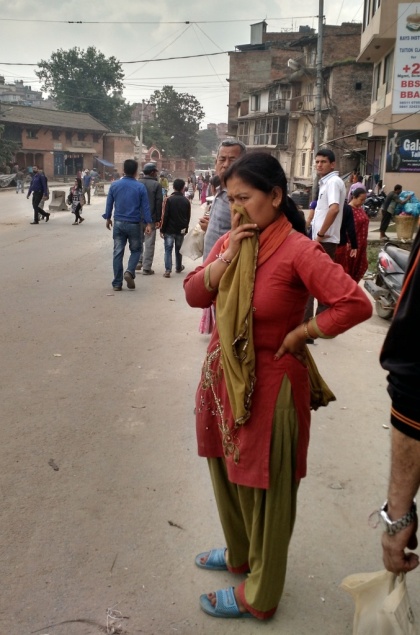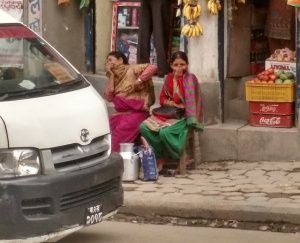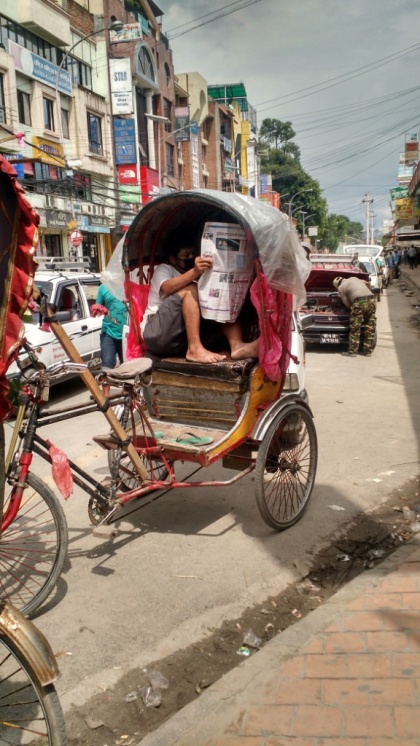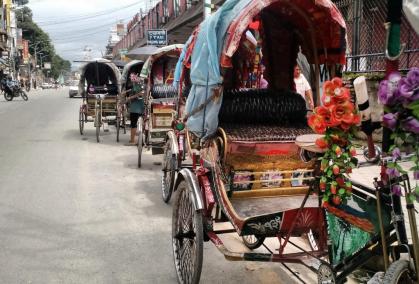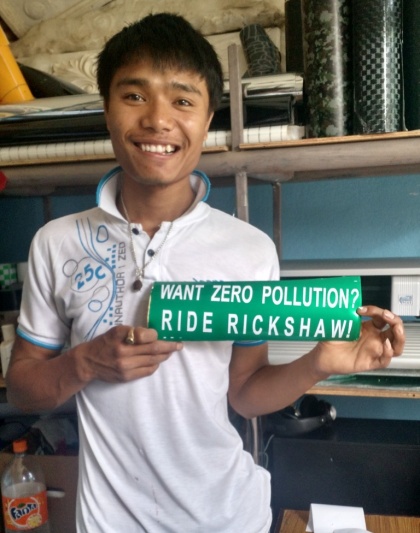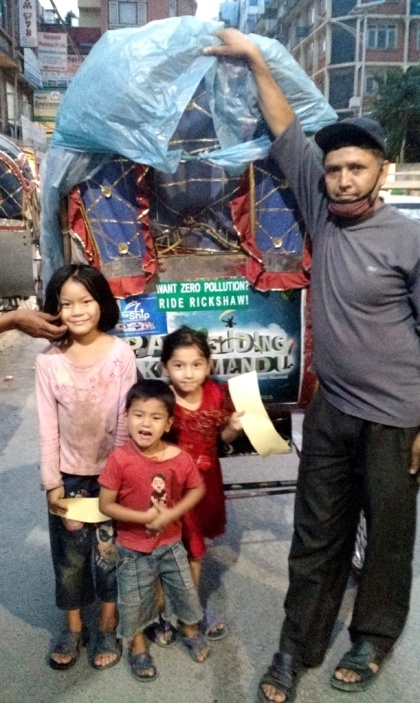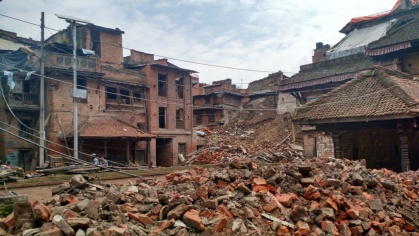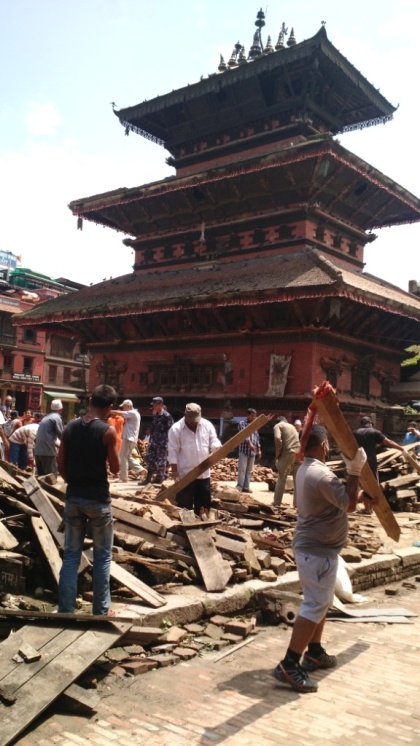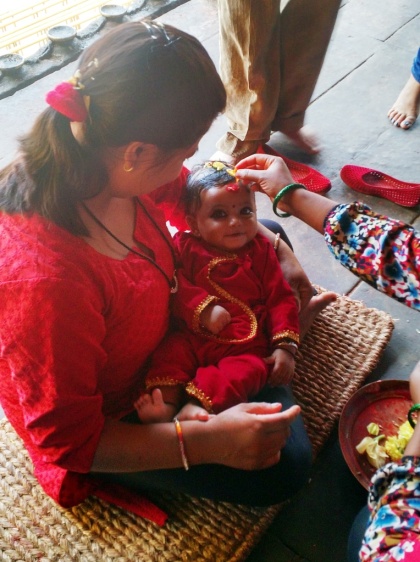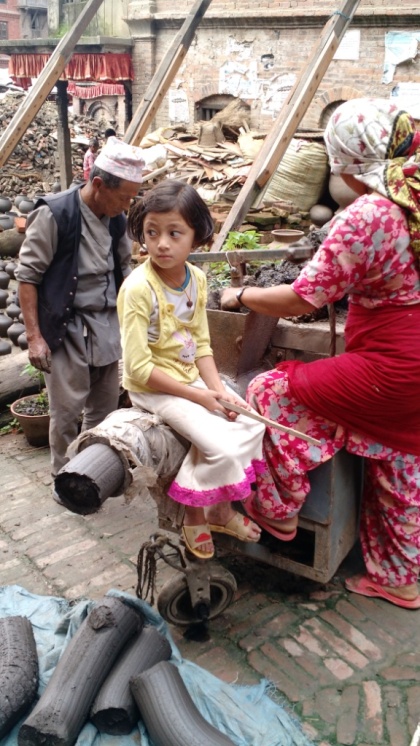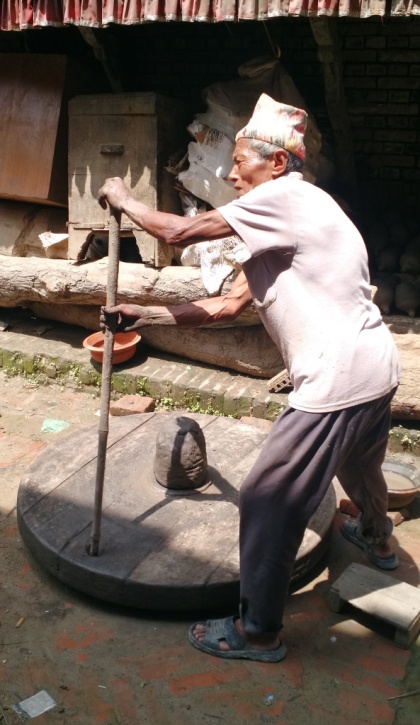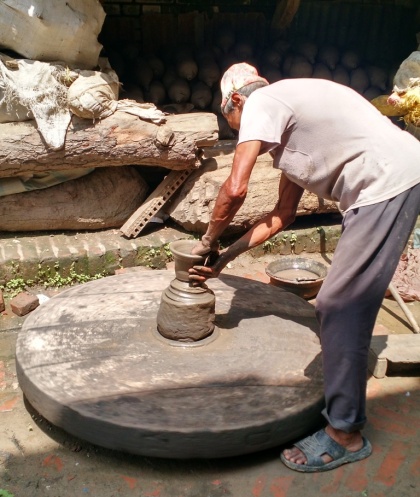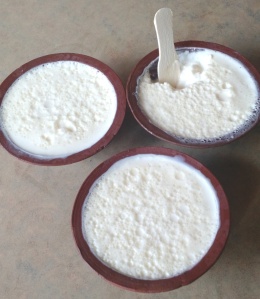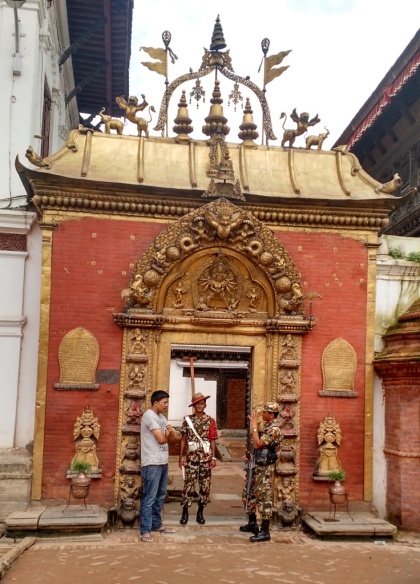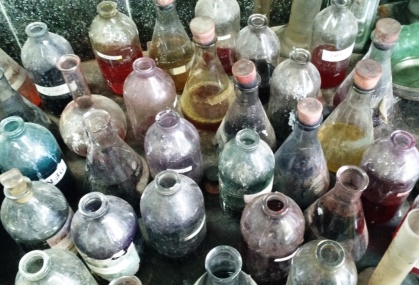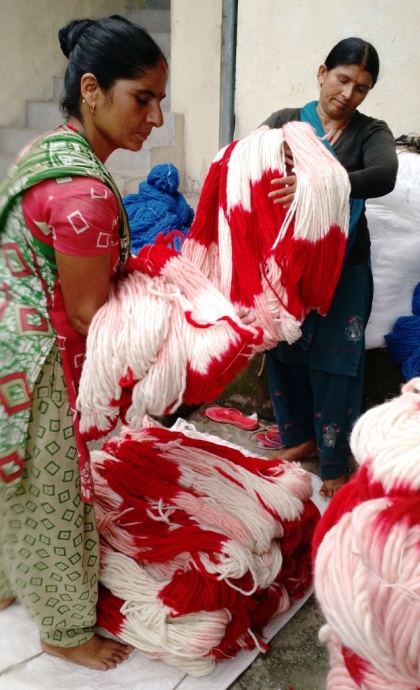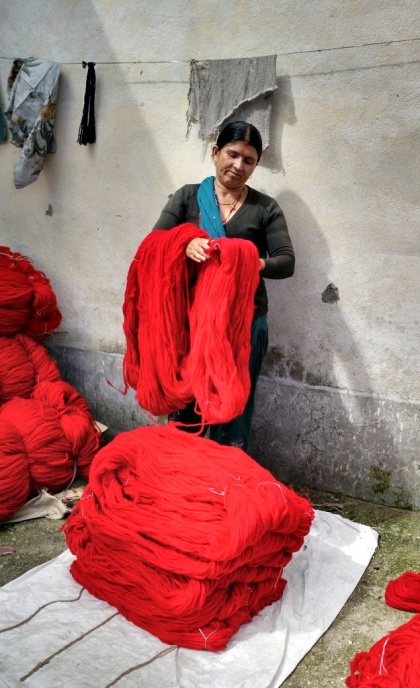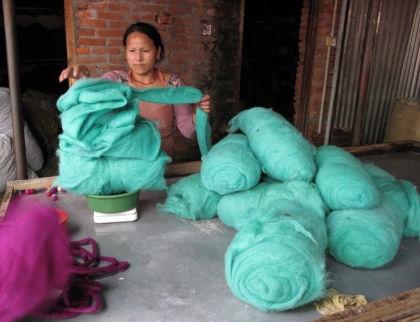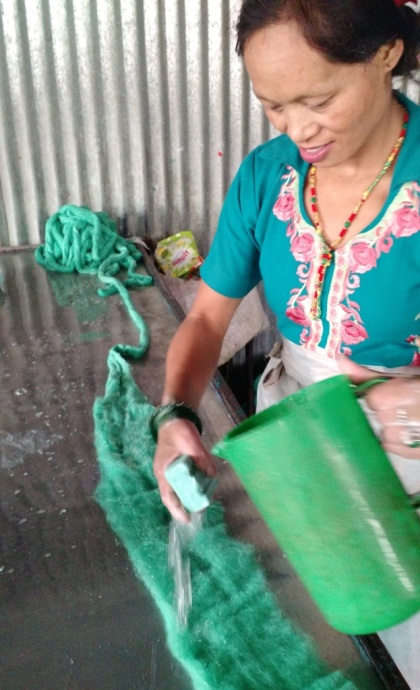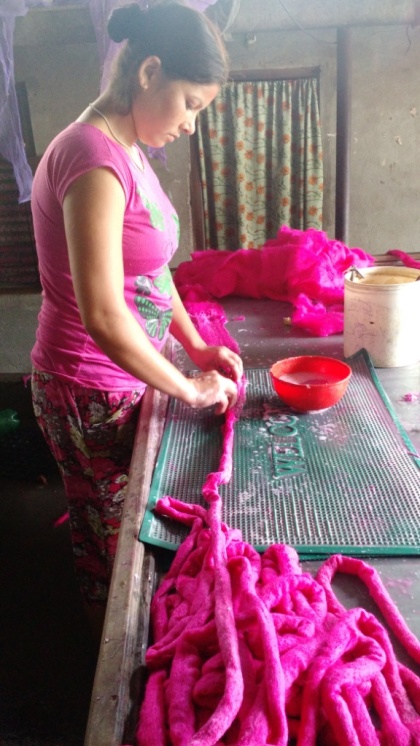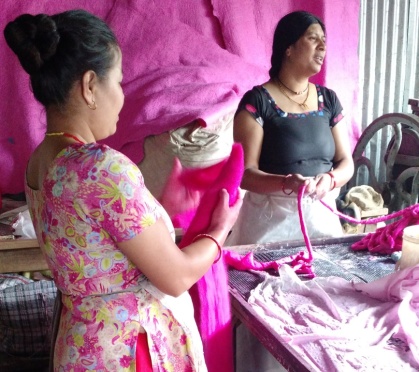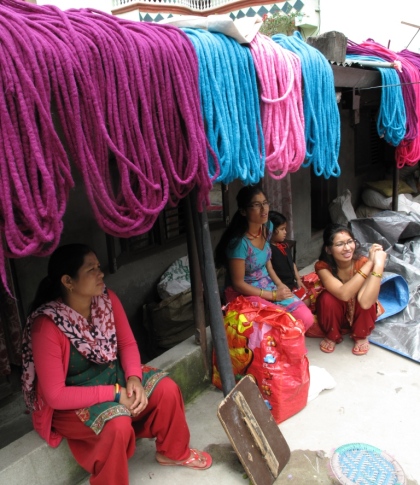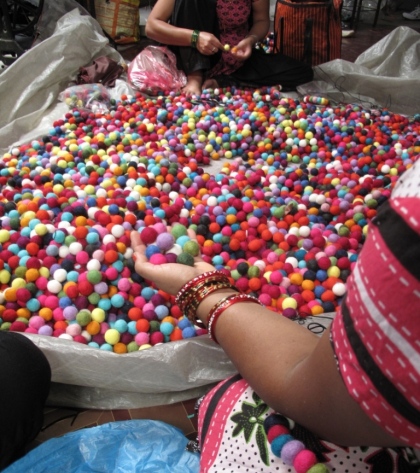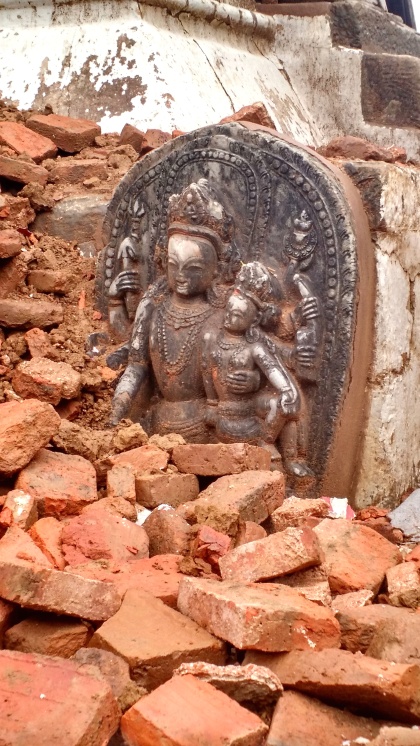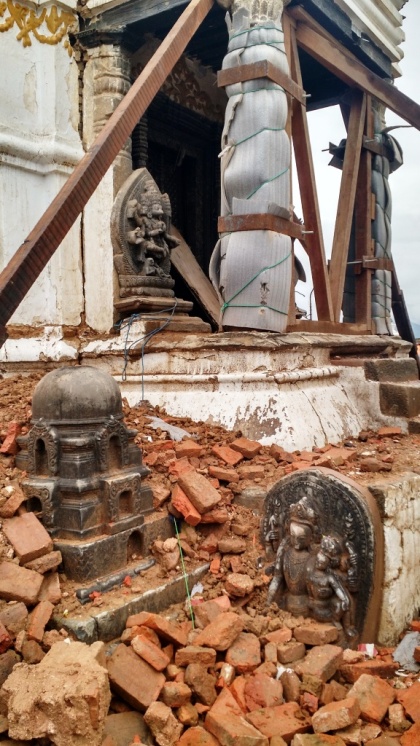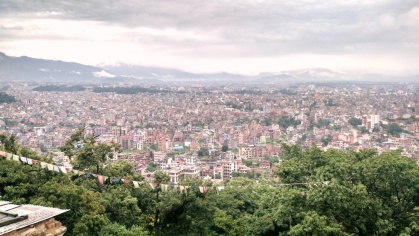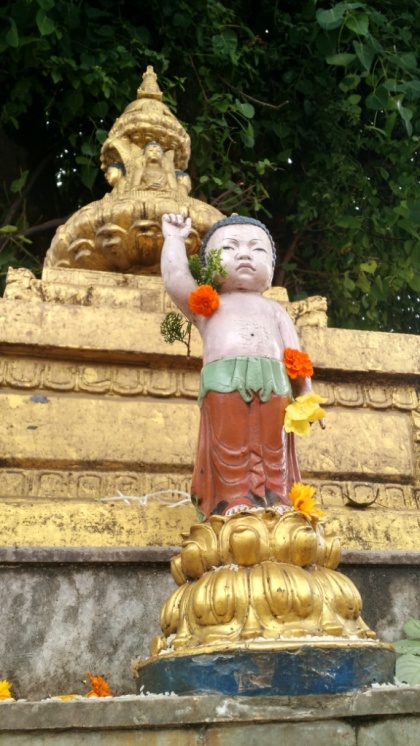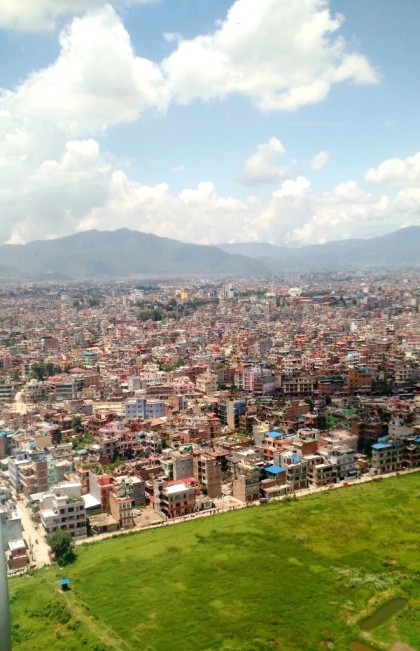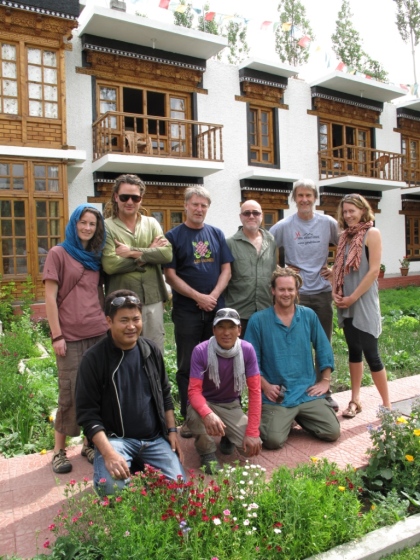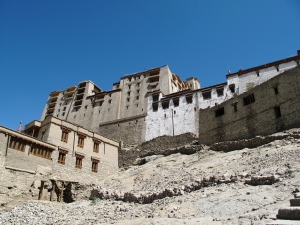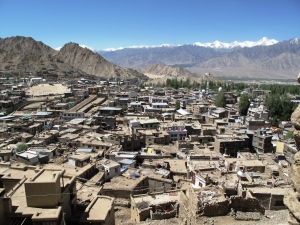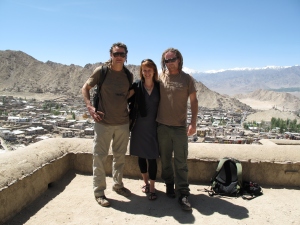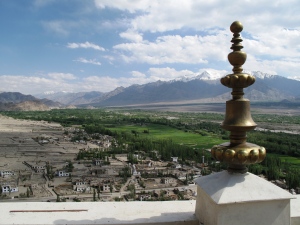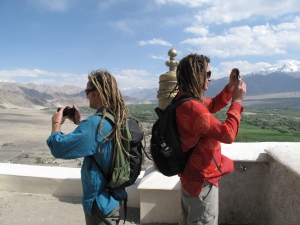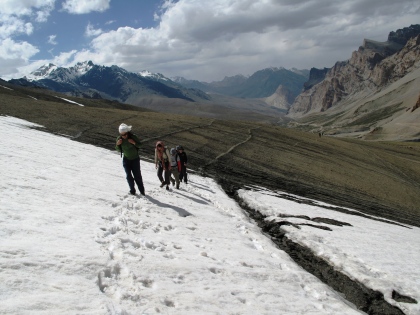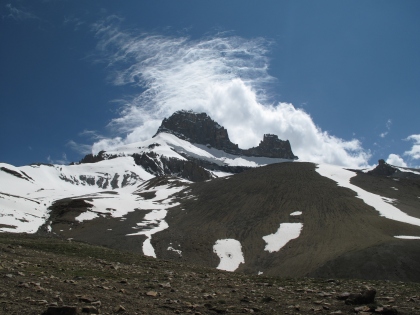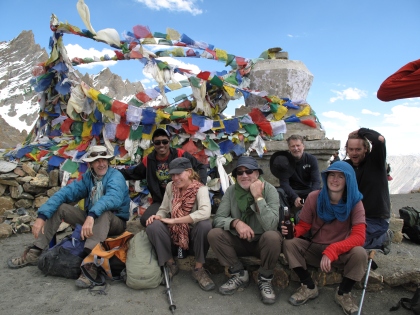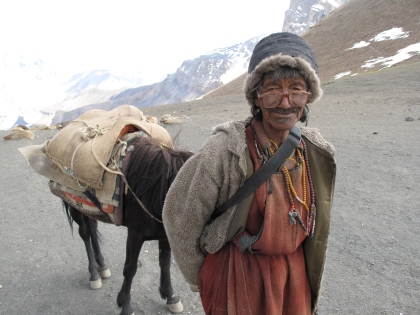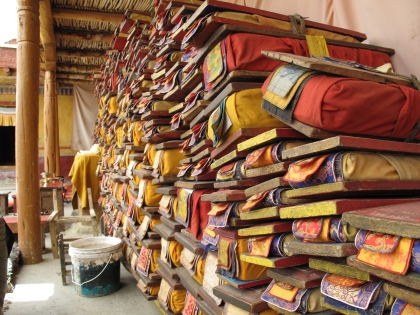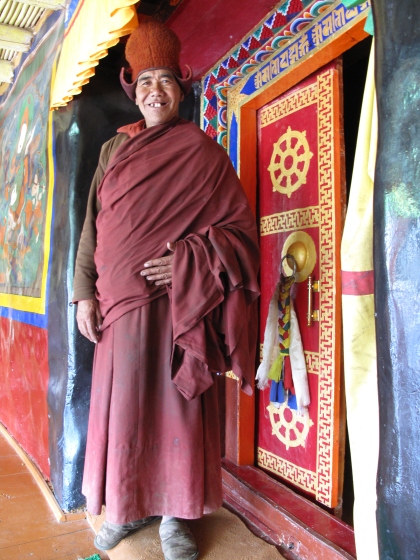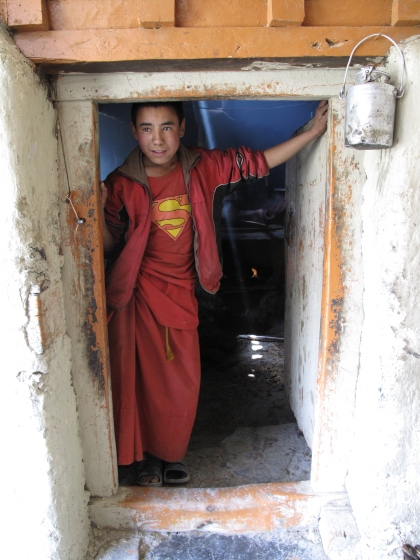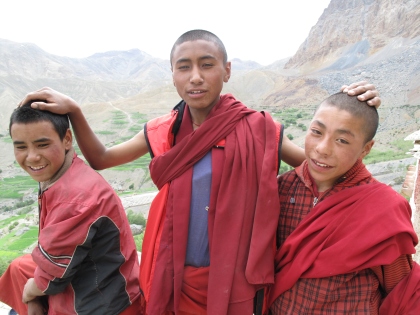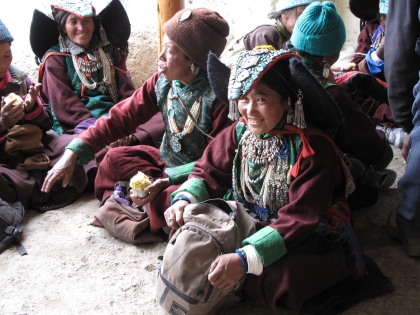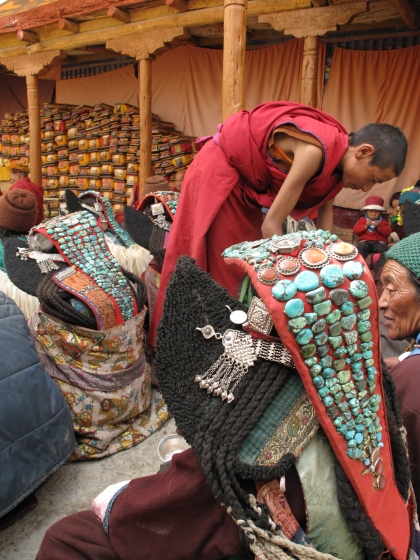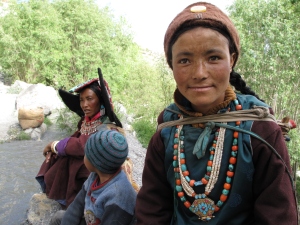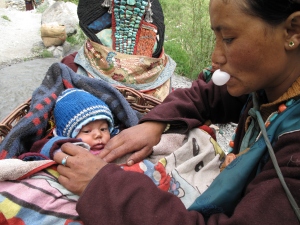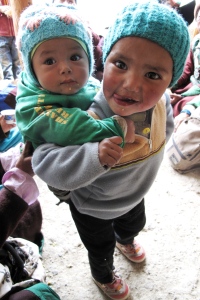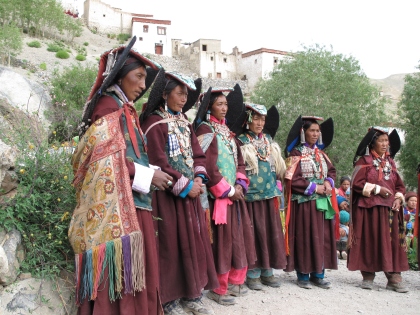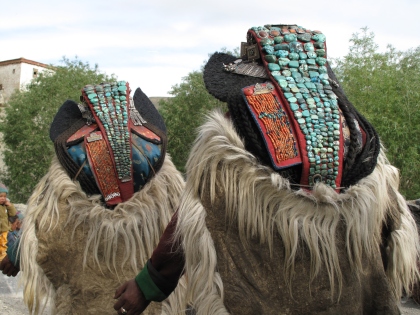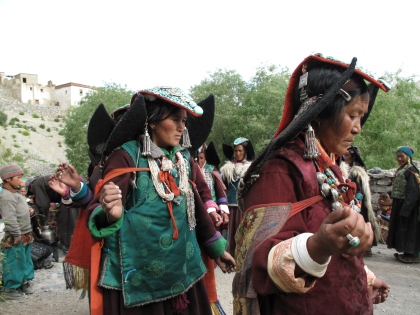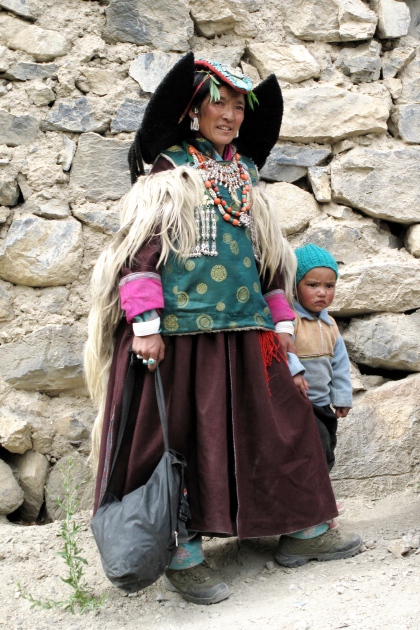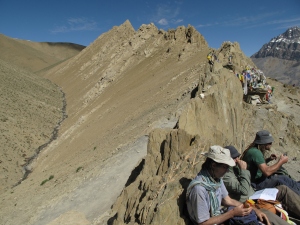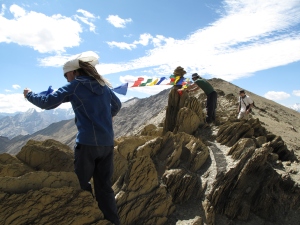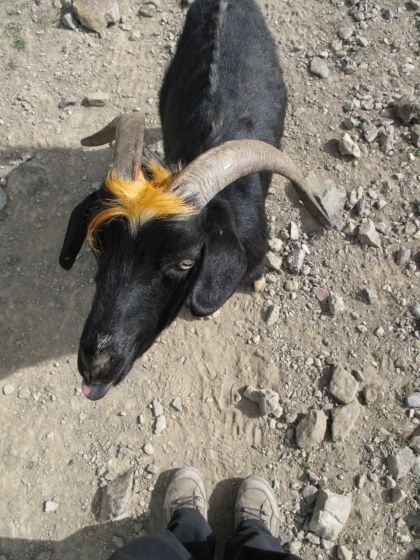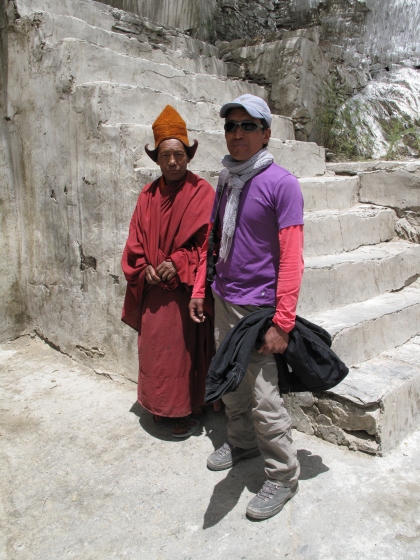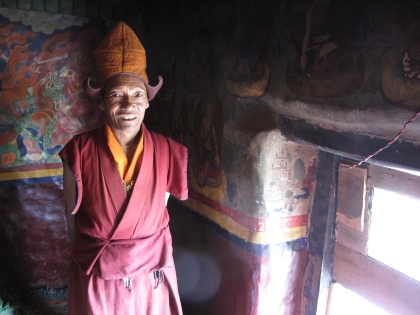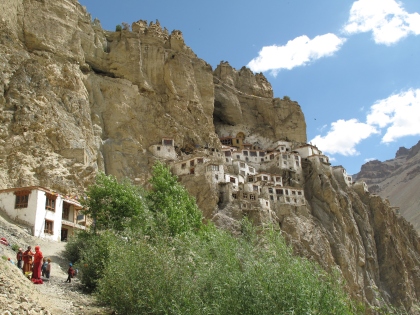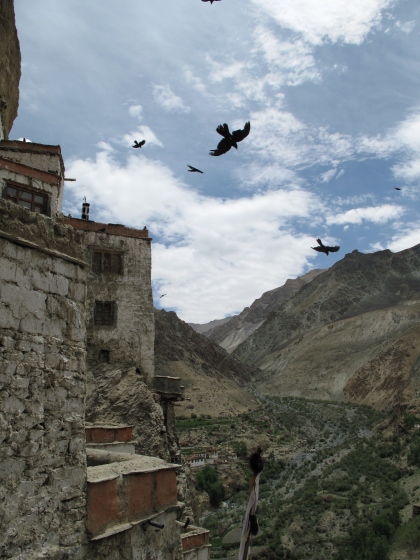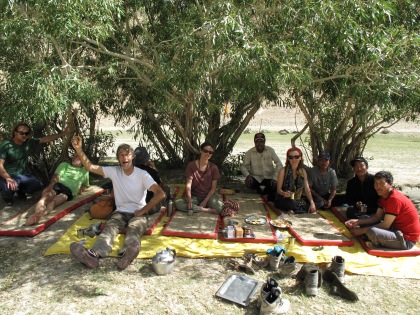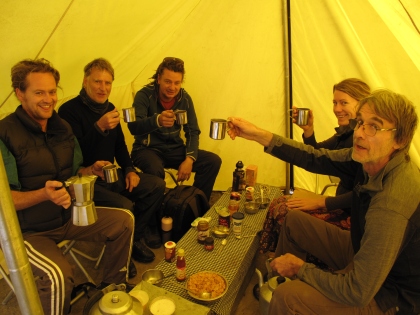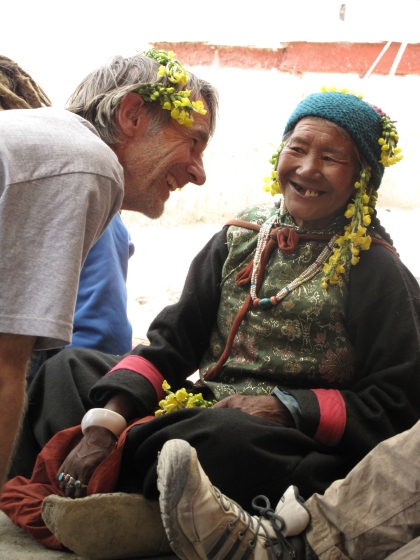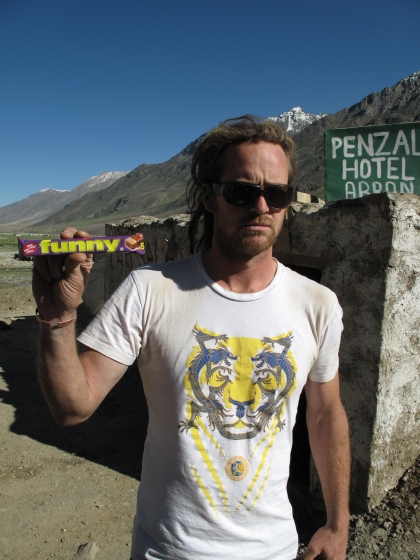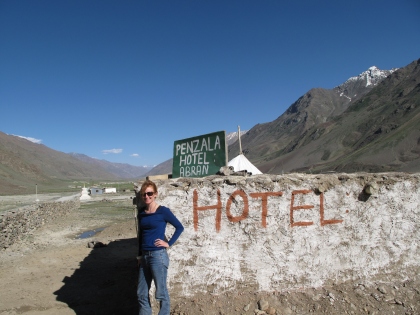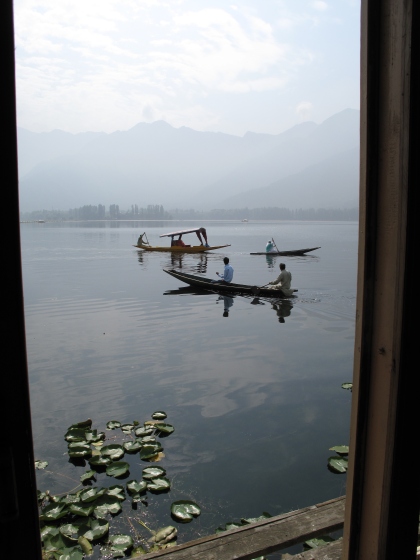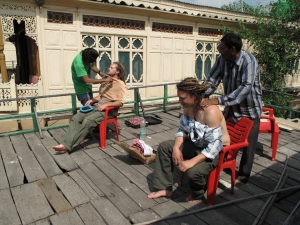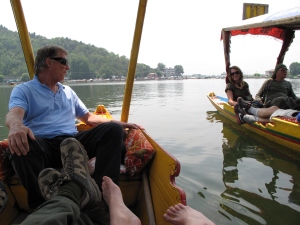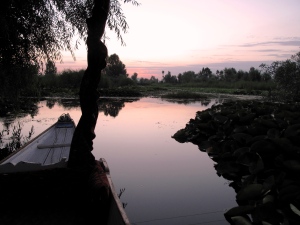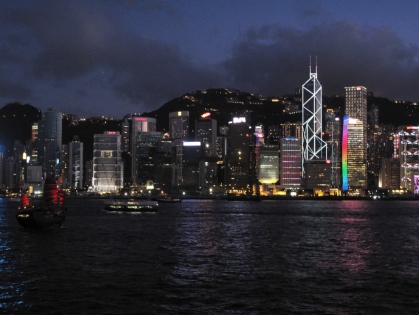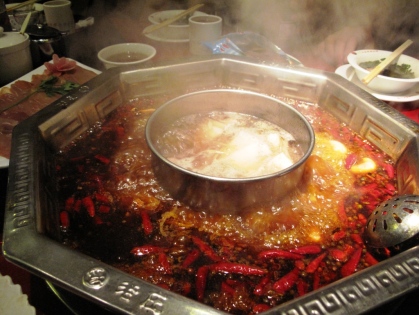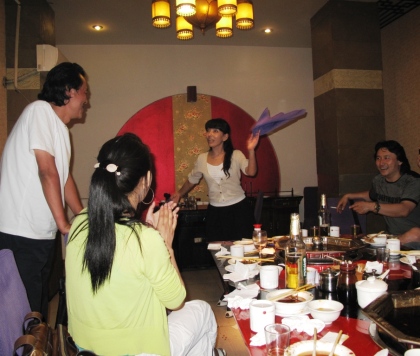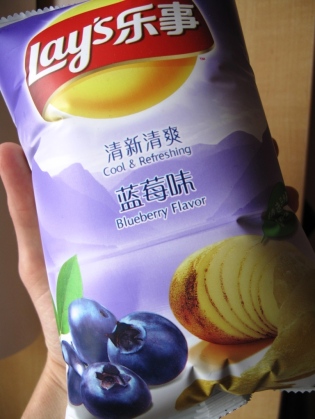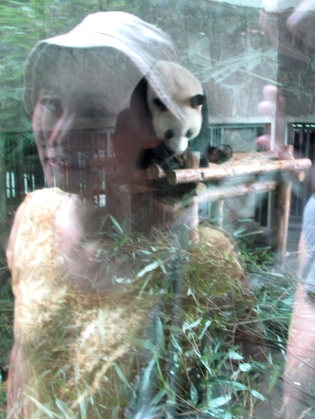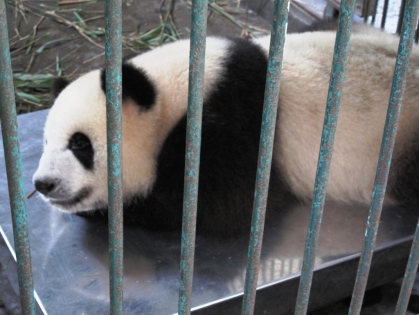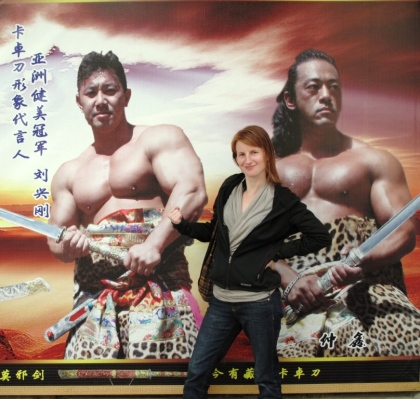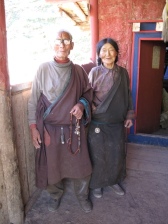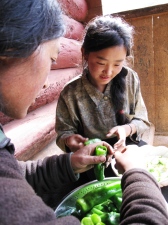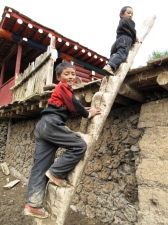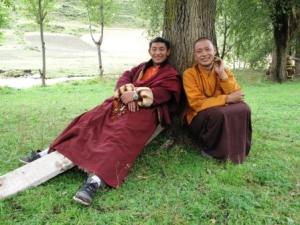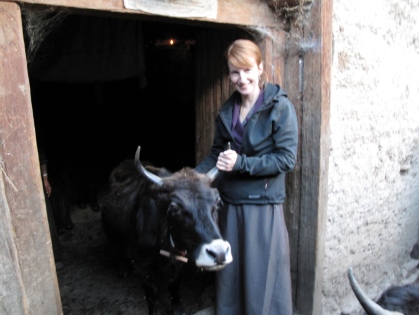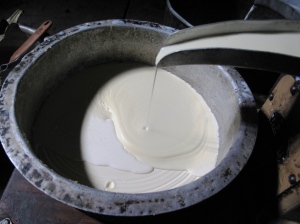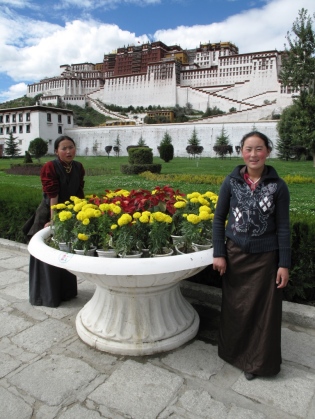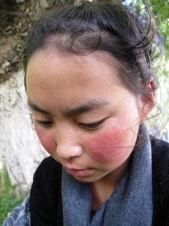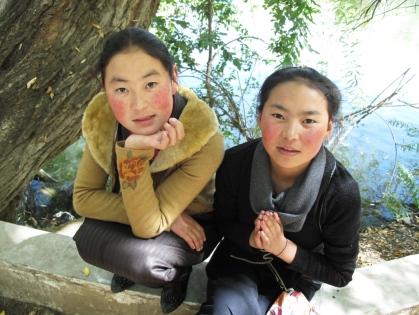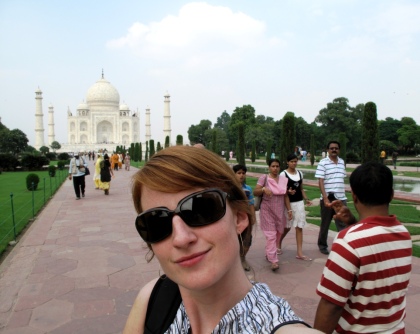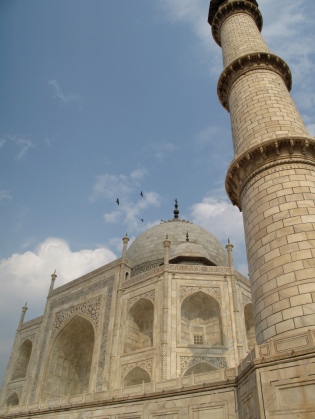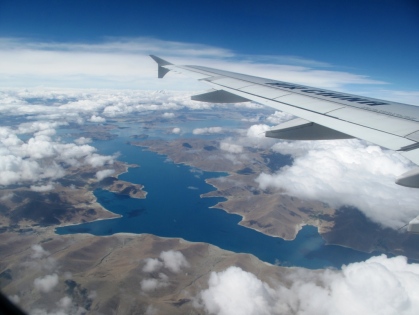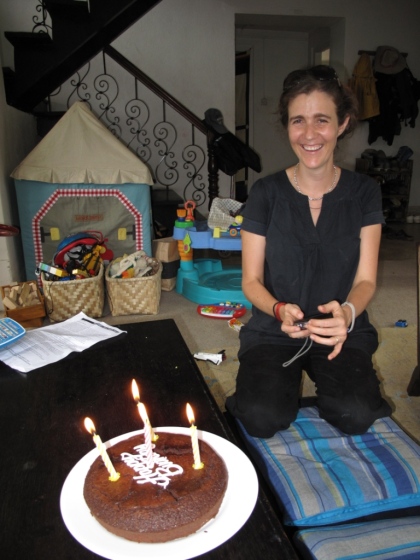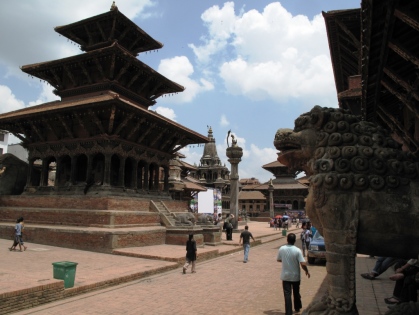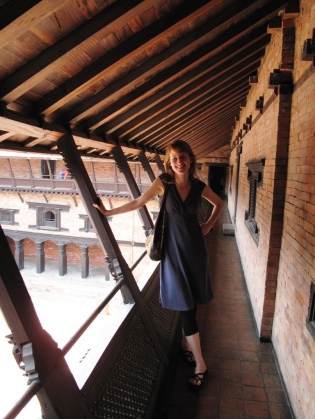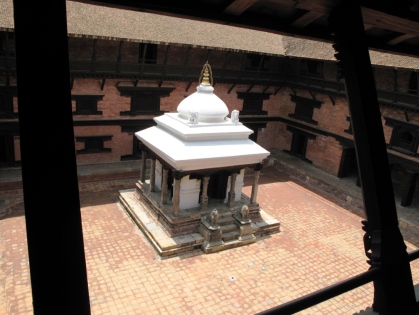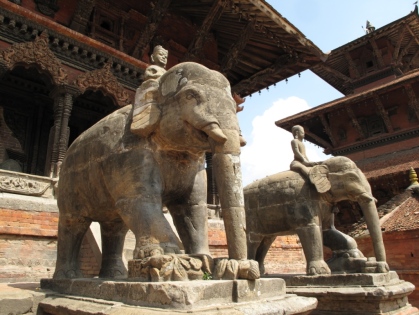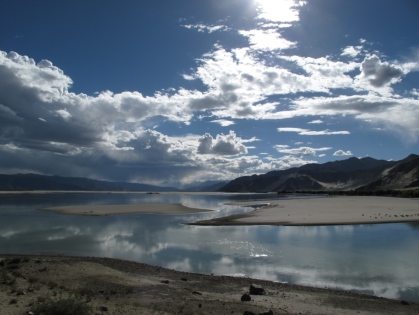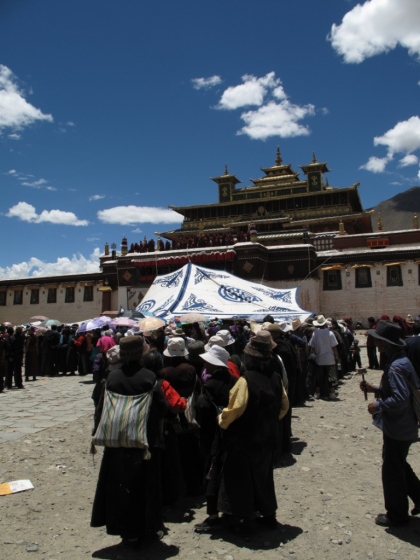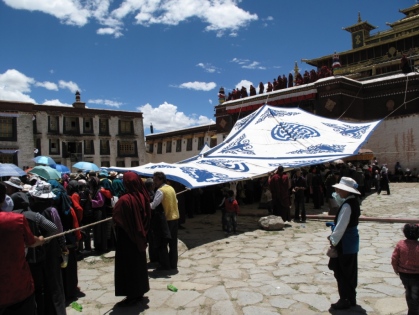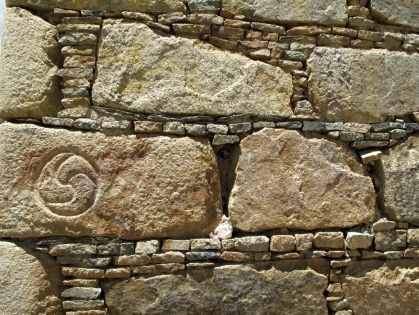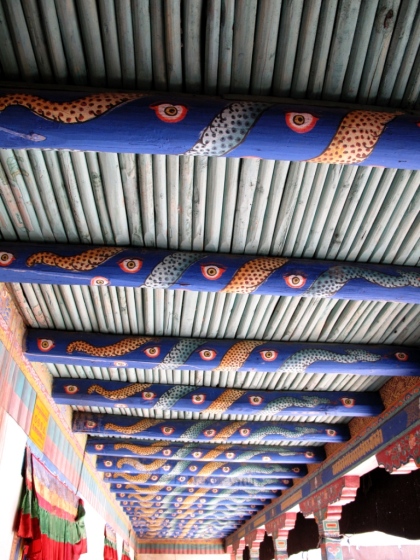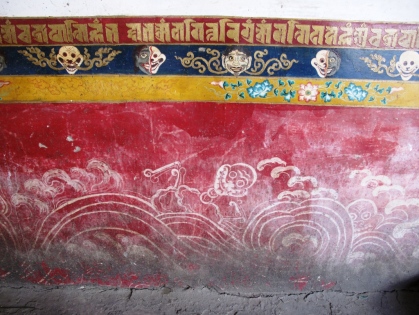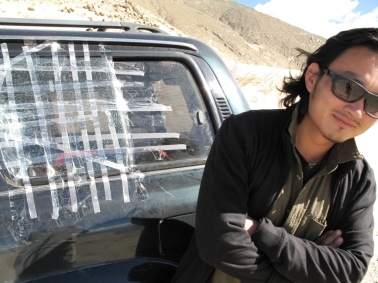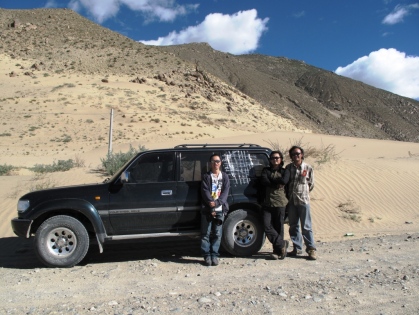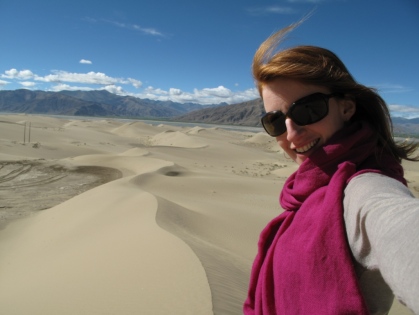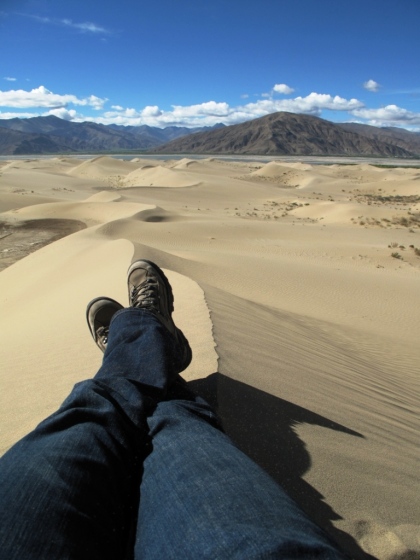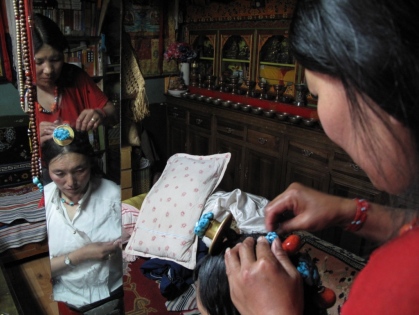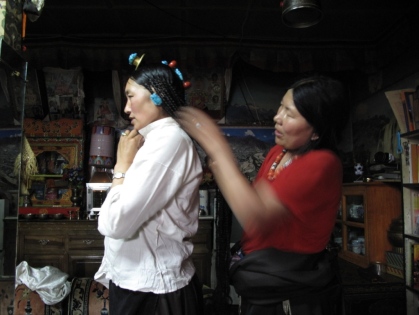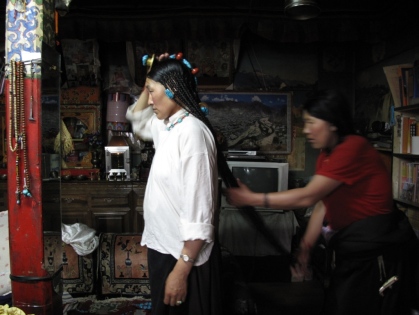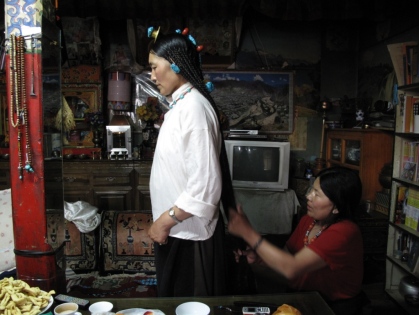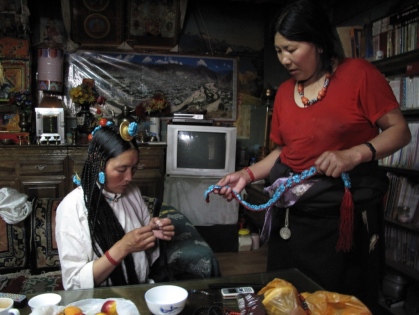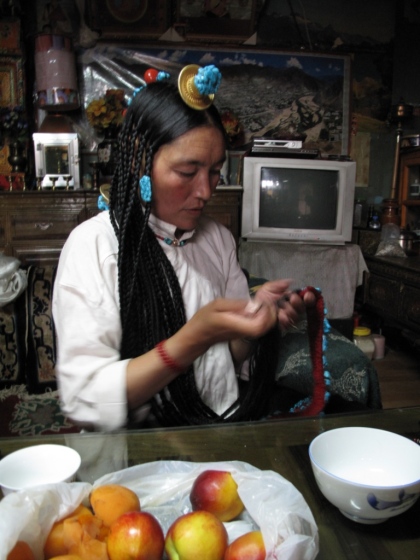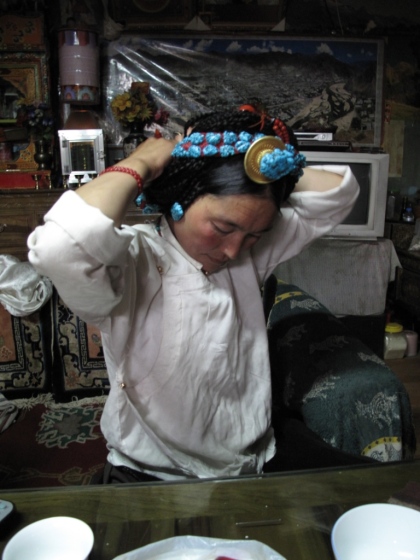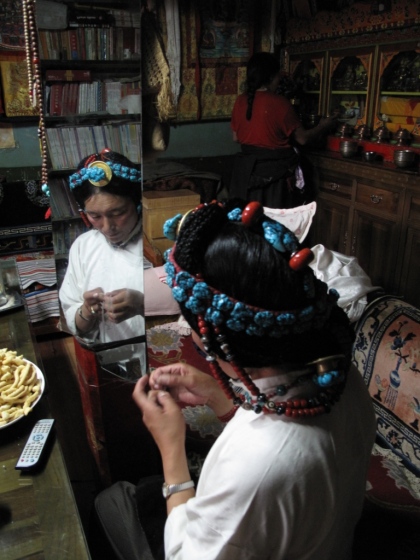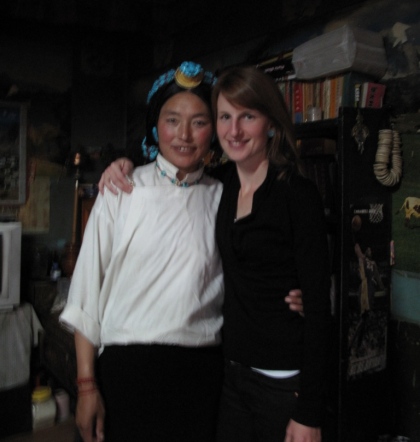Filed under: Uncategorized
No matter how many times I make it to Kathmandu, I’m always taken aback by the pollution. It’s the array of pollution that can be overwhelming, something coming at you from all sides. Out on the streets I feel like I’m always dodging piles of shrapnel or holding my breath through clouds of diesel. Then I fall into those romanticized visions that my old school Kathmandu friends paint of the Kathmandu Valley as just a series of rice paddies and fields dotted with temples and villages. It wasn’t that long ago. Urbanization has been a huge trend in Nepal and Kathmandu is, of course, its epicenter. And just in the past decade it feels like personal car ownership has become so much more attainable. So that means that narrow walking paths are now shared with endless lines of cars and motorcycles. The city is daunting to navigate and the air is gaining new layers of junk.
In terms of pollution one could argue that political instability has had its minor upsides in Kathmandu, particularly with the tradition of holding a bandha or strike. We had 2 consecutive days of bandha last week in which all businesses had to close and all cars had to stay off the roads. The call for this particular strike is a longer story related to the signing of Nepal’s constitution and issues of ethnic representation, but suffice to say that this was just one strike among many. Strikes are common and create a whole new Kathmandu for a few days. During this bandha I borrowed a friend’s beautiful, old granny bike and rode miles around the city, kind of experiencing the old Kathmandu I have built up in my mind. After a good monsoon downpour (during which I huddled with my bike in the doorway of a shut shop), the air felt layers cleaner and lighter and the blue sky burst into focus.
Fighting car traffic in Kathmandu gets me thinking about bicycle rickshaws. It feels like there were so many more rickshaws during earlier visits in the 90’s. They have their pros and cons but as an urban livelihood I really like them. I have to say that I don’t love having a guy pulling me around like I’m a maharaja, it’s definitely awkward, but as a livelihood it’s pretty great when you think about it. But I feel like I see them idle far more than I see them in motion, so it’s only a viable livelihood as long as there are willing patrons to be had.
So since I’m all about making things this journey, I decided to make the rickshaw drivers of Kathmandu a little present. I recently commissioned a small stack bumper stickers that may get people thinking a little bit when they have a choice between a taxi and a rickshaw. There are so many frigging taxis around and the rickshaws can’t compete, especially since there are so many roads now that are too busy for rickshaws. But when there is a choice, I hope people will choose rickshaw. The adventure of making these stickers is a whole other story; the guy below is the maker and it was a painstaking event with little to no shared language over the course of two days. But he loved the project and even offered a discount when he figured out the mission behind it. Anyway, I handed these out in a few areas in Kathmandu, joking around with rickshaw guys along the way. I hope next visit will allow me enough time to make a Nepali version. Keep a look out for these next time you’re in Kathmandu…
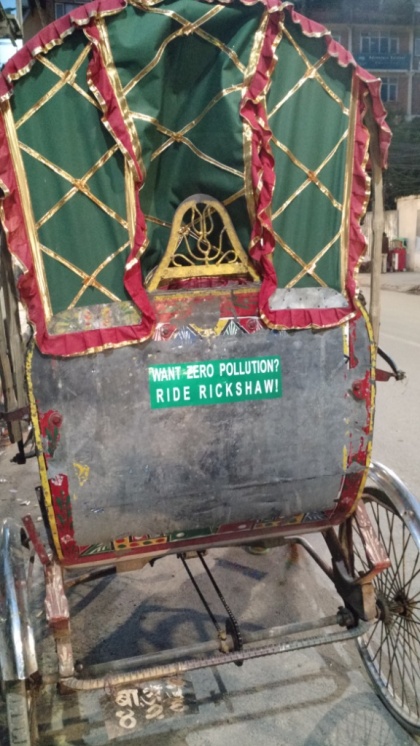
Filed under: Uncategorized
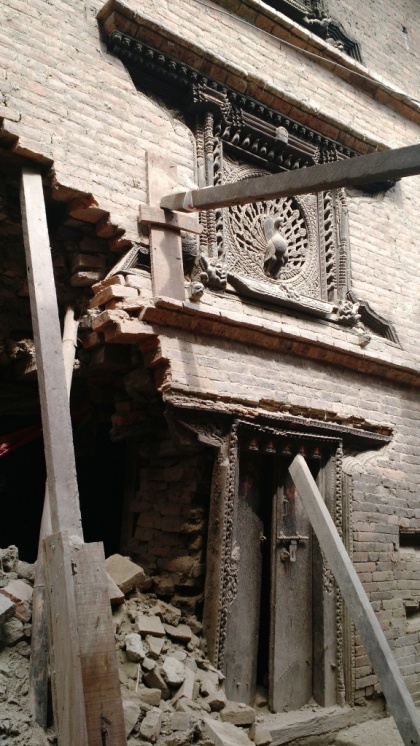
Right after the April earthquake the international media talked a lot about the damage to Bhaktapur, the ancient Newar city here in the Kathmandu Valley. It’s a place where so much significant artistry in wood and clay is preserved, and remains a living city. Its famous Peacock Window (above) has become an icon of Nepal and Newari architecture.
I wandered around Bhaktapur last week with a young Newar friend. At first I was relieved to see much of the city still intact and feel the usual hum of activity; I found myself concentrating on the monuments that somehow did not fall. But as we head deeper into the city, we came upon those fallen building that had not yet been cleared away. My friend said that he now loses his way in some of the back streets of this place he knows so well. Landmarks are gone, pathways are covered by the rubble of devastated structures. He mentioned that the German government has promised funding for reconstruction and preservation; the task will be huge.
There are places where you can see the community coming together to remove the pieces of their broken buildings and mend sacred sites.
We came upon a Hindu baby naming ceremony as we made rounds to the surviving temples. This little honey below was given the name Rosan.
Exploring side streets and alleyways, there are so many woodcarvers and potters at work. We spent some time with a potter and stepped through the process of making a Newari piggy bank.
From processing the clay:
To shaping it on a manual wheel: (This guy had an incredible range of movement and talent in his craft! I have a feeling he’s been doing this for a long time. Needless to say, I was not very successful when he gave me a try).
Then putting the final, fired product out in the sun:
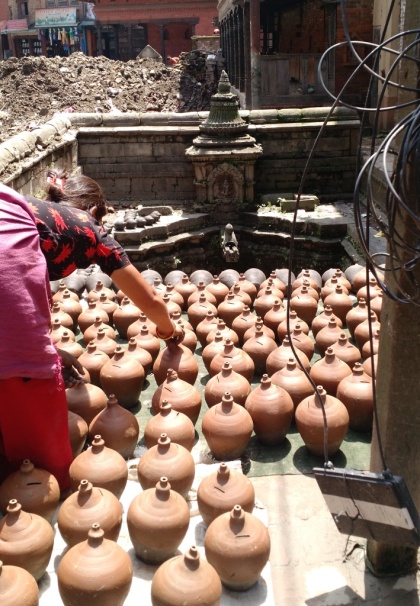
We finished the day with several helpings of Bhaktapur yogurt in the traditional clay vessels. (I will agree with claims that they are the best yogurt makers in the valley!)
On our way out we had one last marvel at Bhaktpur’s Golden Gate, which still stands!
Filed under: Uncategorized
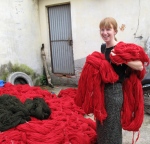 Kathmandu remains a handicraft paradise. You can find something beautiful, go straight to its maker and see them at work. Exploring the supply chain of my little textile enterprise has been an incredible experience so far. It’s a hybrid between a research expedition and a treasure hunt and I’m completely fascinated. Lucky for me, I have partners here that indulge my need to see every step along the path from raw fiber to finished good. I’ve gone from dye house to felt factory most recently. Nepalis aren’t afraid of color and both were a feast of every hue imaginable. I’ve been in heaven.
Kathmandu remains a handicraft paradise. You can find something beautiful, go straight to its maker and see them at work. Exploring the supply chain of my little textile enterprise has been an incredible experience so far. It’s a hybrid between a research expedition and a treasure hunt and I’m completely fascinated. Lucky for me, I have partners here that indulge my need to see every step along the path from raw fiber to finished good. I’ve gone from dye house to felt factory most recently. Nepalis aren’t afraid of color and both were a feast of every hue imaginable. I’ve been in heaven.
The dye house was a pretty impressive operation. They process thousands of kilos of New Zealand wool (Nepal doesn’t have the population of sheep needed to meet market demands) with their own set of carders, then dye the roving any color you can dream up in their lab that consists of a stove top burner and elaborate mess of mad scientist beakers.
With their color prowess, they create beauties like this new line of our yarn!
This lovely lady below had a mountain of red yarn to package for a customer. I tried hard to tempt her to jump into it with me like a pile of leaves (but she was busy).
The dye house staff entertained my interest in seeing everything from the dye vats to the rice husk-fueled furnace, to the water treatment process. People have a lovely way of taking their time with you here, and serving you cup after cup of milk tea (aka chai) in between.
And on to the makers of felt! My partner felt workshop is a tiny but bustling enterprise. It provides flexible opportunities for women who need full or part-time work, and many students who are funding themselves through college. Their skill and patience with their art form is a pleasure to watch.
Felt yarn making in action!
And then there is also mini felt ball crafting that seems to be all the rage these days…
Tomorrow I’m off to a Bhaktapur-based spinning and weaving house. Then later this week I’m back to a women’s empowerment crafts group to meet a master embroiderer to work on labels, then a paper maker for tags. No shortage of stunning talent here!
Filed under: Uncategorized
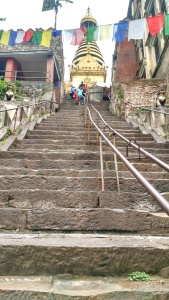 I woke up at sunrise my first day in the city and hiked up to Swayambhunath, also known as the monkey temple. Monkeys do indeed abound at Swayambhu and they get all up in your business. When they’re not leaping across the sky above your head, they’re busy doing funny things like chilling on a rock eating a Kitkat or staging a showdown with street dogs over stolen groceries. Anyway, back to my original subject: Swayambhu. I’d say that morning is pretty magical at most pilgrimage sites and Swayambhu always delivers in that respect. Up there you’re above all traffic and noise, just you and a whole bunch of people who hiked up to fulfill their ritual duties and pray. It could be any year, but most likely one that feels like several hundred years ago.
I woke up at sunrise my first day in the city and hiked up to Swayambhunath, also known as the monkey temple. Monkeys do indeed abound at Swayambhu and they get all up in your business. When they’re not leaping across the sky above your head, they’re busy doing funny things like chilling on a rock eating a Kitkat or staging a showdown with street dogs over stolen groceries. Anyway, back to my original subject: Swayambhu. I’d say that morning is pretty magical at most pilgrimage sites and Swayambhu always delivers in that respect. Up there you’re above all traffic and noise, just you and a whole bunch of people who hiked up to fulfill their ritual duties and pray. It could be any year, but most likely one that feels like several hundred years ago.
My trip up to the stupa coincided with the day of the full moon, a holy day, so everyone was busy in their devotion. Offerings being made to the tiny temples and icons surrounding the stupa were accompanied by the beautiful music of 50 or so Newari Buddhists singing and playing instruments. I sat with them for about an hour and listened. I then befriended an old Tibetan monk who walked me through the earthquake damage of the site as we did the pilgrimage circuit. The stupa’s spire is intact but one of it’s two major side temples collapsed, the other one is propped up by scaffolding like a huge crutch.
This was the first place I really took in the earthquake damage, this place I’ve been coming to for almost 20 years now, and started to hear people’s stories. My new monk friend had bricks rain down on him, injuring his hip and legs. Looking down at the city, he pointed out other places that had fallen.
The damage is certainly bad here in the city itself, but I’m surprised by the beating many of the sketchiest of buildings were able to withstand. A friend here mentioned that an international committee of seismologists visited a few years ago and forecasted that quakes of this magnitude would demolish 60-70% of all buildings and take out 40% of the population. Thanks to all that is good in this world, they were wrong.
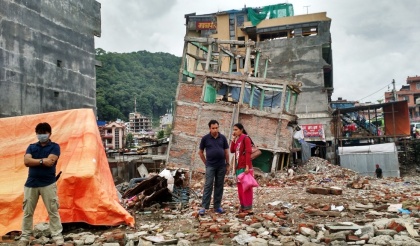
As you walk around the city, life goes on as it has to but it seems to me that Nepali people do it with an admirable amount of tenacity and joy. A member of my hotel staff was showing me post-earthquake pictures of his village on his phone. It was leveled. But as he looked at these disturbing images he said to me, “Nepal is still alive, Madame.” Later that day I saw a shirt for sale in the market with an image of Dharahara, the city’s historical watchtower that fell killing close to 200 people. The shirt read: “We will rise again.”
Filed under: Uncategorized
Flying into Kathmandu is incredible, particularly in monsoon season. A 777 can feel like a prop plane next to the gigantic rain clouds and thunderheads. It’s frightening too; when you’re enclosed by clouds you have no idea how close you are to plummeting into mountains (thank you, oh inventor of radar!). This time all the beautiful anticipation of being back in Nepal was mixed with sadness and trepidation around the situation since the earthquake. The mountain villages look perfect from above, as does the Kathmandu Valley. You can’t see the damage but the vulnerability is clear. The city’s tightly-packed brick and concrete buildings look so miniature and fragile.
I was relieved to see much less damage than I had feared during that first drive from the airport across town. I’ve seen more since, but I’m so grateful for the reality not matching my imagination in many instances. Much more to follow. Power and wifi are playing super hard to get!
Filed under: Uncategorized
By popular demand, I’m posting a long-overdue highlight post from our 2012 trek into Zanskar, Ladakh. It was one of the best yet and reunited much of the Kailash crew from earlier posts, with a few wonderful new additions.
Ladakh is among my favorite, favorite places. I’ve spent several long stretches in Leh doing research on lhamos and lhapas, the spirit medium healers of the region. But this time I hit completely new territory and made it to the remote Zanskar region. This journey is of particular significance now as the region was recently cut open by its first vehicular road, something locals did not seem at all happy about. If the road has indeed been completed, we were one of the last groups to be free of the traffic of jeep safari tourism.
This is a skim through our adventure; more visual than informational as I’m away from my journals and itineraries. It was a dream trek. Namgial from Yama Adventures is your man if you’re ready to go.
The group unites in Leh!
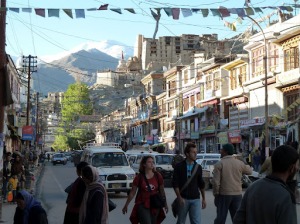
Leh had done some serious changing since I was there last, almost a decade before. So many more tourists and local families meeting traveler demands by plopping hotels and restaurants over their barley fields and pastures. Long walks I used to take just past the city’s edges with farmers threshing and working their land were unrecognizable with bars and trinket shops.
But Leh Palace, Tikse monastery, all the beauty of the surrounding area remain just the same.
The first and biggest pass crossing came early on the trip. We hit the 5k meter pass after a long decent up a glacier and had a beautiful rest at the top in the thin air. It was a trudge for me. Sea level San Francisco had me out of shape no matter how much biking/hiking we do.
The first and biggest pass crossing came early on the trip. We hit the 5k meter pass after a long decent up a glacier and had a beautiful rest at the top in the thin air. It was a trudge for me. Sea level San Francisco had me out of shape no matter how much biking/hiking we do.
The first and biggest pass crossing came early on the trip. We hit the 5k meter pass after a long decent up a glacier and had a beautiful rest at the top in the thin air. It was a trudge for me. Sea level San Francisco had me out of shape no matter how much biking/hiking we do.
The pass was a piece of cake for this Zanskarian.
Our visit to Lingshed Monstery ended up being on just the right day. The community was gathering for an annual festival. The monks had just finished a multi-month recitation of their library of Buddhist text and were ready to entertain.
Everyone in the surrounding villages had brought out their finest gear to celebrate. The women are adorned in their perak, a traditional headdress with more turquoise than you can imagine seeing in one place!
We ascended another pass the next day, one with the most wonderful view of Lingshed. It was my favorite pass of the trip, just something about it. I could’ve stayed up there all day watching birds ride the gentle thermals. We hung prayer flags before descending.
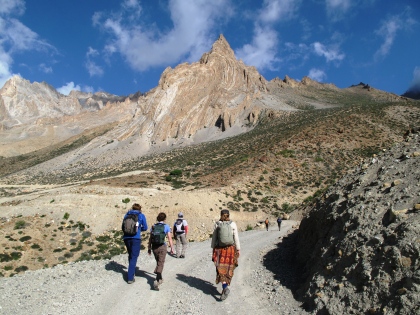
The Zanskar landscape deserves a post all its own, just such incredible high altitude desert. Treacherous pathways were something I slowly grew accustomed; particularly frightening when a herd of donkey come your way and there’s no where to go.
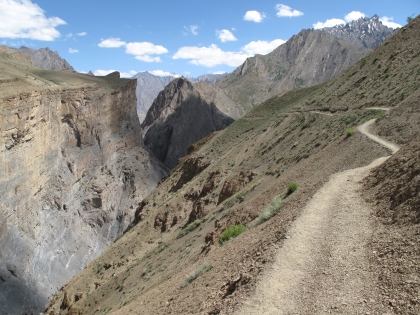
There’s so much life too; the Ladakhis have been ingenious in their use of glacial water irrigation.
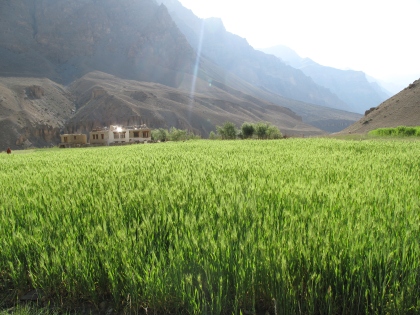
And we had some friendly contact with the famous pashmina goat (the prized hair is on his underbelly!).
Another highlight was Tashi, our guide, taking us to meet his uncle at his monastery.
We made it to Lamayuru, the ancient and ingeniously perched monastery.
The group was always in good form!
At the end of our trekking days we jumped in jeeps and made our way to Srinigar. We cleaned ourselves up and lounged around in houseboats; heaven from start to finish. Thanks again, team!
Filed under: Uncategorized
Okay, I’m going to skip waaay ahead now. I’ll need to skim through 4 months of territory, and it hurts to do so, but this catch up game is getting out of hand. I’ll give a quickish recap that brings us up to now, just some highlights via visuals.
After Kathmandu I head to China’s Sichuan Province via Hong Kong. I love that city, even in the height of summer. I spent a lot of time strolling the Kowloon promenade admiring the skyline:
I then head to Chengdu, the capital of Sichuan, where I began the next stage of Foundation work. After months of mostly clear mountain air and then the balmy but blue skies of Hong Kong, Chengdu was a shocker. Suddenly I had gone from the left to the right:
And it was the scene on the right that greeted me from my hotel room window on my first morning. Chengdu feels like it has been fastened with a gigantic gray ceiling. Smog and/or haze always looms. But the sweet people and slowish pace made me come to adore the city, as did the access to cheap, high quality massage.
The food has its charm too. I had my fill of incredibly hot hot pot. Chilli oil is brought to the boil to become a fondue for raw meats and veggies. The center chamber is for wimpy non-chilli lovers like me:
And I found out that the combo of hot pot and 100-proof rice wine commonly causes people to jump up and dance around the dinner table (for hours). I’ll spare you the extensive video footage, but give you this action shot (just FYI, the napkin dance lady below is a semi-famous Tibetan pop singer):
I also discovered that in China, Lay’s Potato Chips come in Blueberry Flavor:
Roaming outside of Chengdu, I spent some time amongst Sichuan’s beloved Pandas:
Apparently, so did Don King:
And hung around with very large Tibetan men:
I ventured out to see my best friend’s family in an enchanted corner of eastern Tibet:
And I gifted them a dzomo (a cow/yak hybrid):
We milked her:
And churned her milk into butter:
I went back to Lhasa:
And was reunited with two very close friends I hadn’t seen in over 7 years:
The once tiny, rosy-cheeked children I had known have grown into beautiful young women. Both are now cell phone addicted and boy crazy but the rosy cheeks remain:
Moving closer to the present, I flew back over the southern edge of the Himalayas and made my maiden voyage to the Taj:
It was more magnificent than I had thought possible.
I then took a break with an adventure through Rajasthan (incredible, incredible place), but my eyes are glazing over at the task of deciding which photos to highlight so this will have to do it. I’m back to Asia shortly for the second segment of work with my lovely colleagues at the Foundation.
Filed under: Uncategorized
So by the end of June our huge kora had been completed: from Nepal up to Kailash and Guge, across to Lhasa and back down to Nepal. I then returned to Kathmandu where the trip had started. Though this time there was no hiking across the border–without my Kiwi companions I took the easy route with an early morning flight from Lhasa to Kathmandu. It’s an expensive fare but it’s fast and takes you right over Everest. I was too slow to reach my camera in time for that pivotal moment. Instead, here’s a watery expanse of the Plateau I captured somewhere 31,000 feet above sea level:
Reaching the Nepali capital, I again went straight to the home of my lovely friend Kats. My last night in Lhasa involved no sleep and a marathon of karaoke so my first hours back in KTM were spent sound asleep in her sunny guest room. I was finally roused by the smell of warm chocolate as Kats and her son finished baking a belated birthday cake for me. They did an incredible job. (Devouring three cakes in a week really raises the bar for birthdays of the future).
Then I think I may have actually gone back to sleep. This time I’ll co-blame it on a sudden overdose of oxygen after being above 12,000+ feet for the past seven weeks. Kathmandu seems like it would be a high place–it kind of evokes that image with all its enchanted Himalayan kingdom associations–but it’s actually more or less the same height as Denver. (Now that kind of kicks the mystical frills right out of it). Also let it be known that a sudden decrease in elevation and the resulting increase in oxygen does not necessarily give you a surge of super-human strength or energy (as I have also assumed), it often just works to make you feel nothing but sleepy.
Anyway, during my actual waking hours I readied myself to start my new position and explored some old favorite spots with Kats. We had a gorgeous afternoon in the ancient city of Patan where we strolled around a museum of art and drank lime soda overlooking the city’s royal courtyards and temples.
And onto Hong Kong!
Filed under: Uncategorized
A few days before leaving Lhasa I joined some friends on a trip to Samye, Tibet’s first Buddhist monastery. Situated in a wide river valley, the temple complex is built in the shape of a giant mandala. We were there for the full moon and the beginning of the annual cham, a festival of religious dance performed by Samye’s monks.
The last part of the drive courses through dunes and follows a river that stretches along the sand like a big broken mirror:
That night we wandered around the temple grounds in the moonlight and stumbled upon camps of local pilgrims singing and dancing in large circles. They kept it up until way after midnight. In the morning, festivities were in full motion with those same pilgrims waiting for their turn to enter the main temple to receive blessed pills (small, round pellets of sweetened barley flour and butter) from a high lama. A few thousand people were on-site by mid-day. Here is the end of the line:
We didn’t get our chance to make it into the temple, far too much competition. But as I was wandering around, a monastery carpenter pulled me aside and gave me a handful of the prized blessed pills. With them, he gave me a short lecture on the benefits of their blessing to my life and body and made me promise that I’d bring some back for my Dad. He was very insistent that my Dad be the recipient, keeping my Mom a little lower on the list for some reason. Seeing that they are made from a substantial amount of butter, and that my Dad may not appreciate being fed pellets of soon to be rancid Tibetan butter in 6 months from now, I ended up giving the rest to appreciative friends in Nepal. After the sweet gift and conversation, I wandered around noticing the little details of this thousand+ year-old monastery:
When the monks were just about to start their dancing, my attention was diverted to the main reason for our Samye trip: to present 50 large garbage cans to a nearby community of cave meditators. Yup. We were actually there to help a set up a waste management system and transport the heavy bins up the side of a mountain.
I’m afraid I don’t have any photos of the process, which was humorous. We were met by a few dozen nuns from the community’s nunnery and together we fastened the heavy bins to concrete bases and hauled them up the hillsides until past dusk. That night we were invited in for a meal and a bed in a high lama’s shrine room and then packed up after early morning prayer ceremonies the next day.
But after hiking down the mountain and returning to the car, we found that we had locked the keys inside. To get in, the back window had to be shattered. MacGyver-like, we propped the broken pieces of the window back into place with some Scotch tape I just happened to have in a pocket:
We then took a little time to play along the dunes. Despite the obvious fun of dune-play, desertification in this region is no joke.
Filed under: Uncategorized
 In honor of Halloween, this post will be dedicated to cool costumes– or more specifically, headdresses. My friend Tsetru wears the most magnificent collection of turquoise and coral in her hair. Her style is typical of her home area in eastern Tibet, where most women still wear this ornate gear. But our adventure to the hot springs necessitated that she take them out (possibly for fear of sinking). When we returned to Lhasa, I hung around for the 3+ hours that it took to braid, weave and sew the jewels back into her gorgeously long hair.
In honor of Halloween, this post will be dedicated to cool costumes– or more specifically, headdresses. My friend Tsetru wears the most magnificent collection of turquoise and coral in her hair. Her style is typical of her home area in eastern Tibet, where most women still wear this ornate gear. But our adventure to the hot springs necessitated that she take them out (possibly for fear of sinking). When we returned to Lhasa, I hung around for the 3+ hours that it took to braid, weave and sew the jewels back into her gorgeously long hair.
After a good wash, she braids her hair into around 50 smaller braids. Then, with the help of an in-law, sews a felt strip adorned with chunks of coral, turquoise and the larger gold and turquoise piece, to the hair at the crown of her head:
Also with needle and thread, she then attaches two side pieces at the height of each ear:
They check their work:
Then ready to attach the next piece: a strip made of woven red string adorned with dozens of chunks of turquoise and strings of coral beads:
She attaches it by tying one end with a string to the middle of her mass of braids:
Then wraps her hair and the attached strip of beads around her head like a long, incredibly heavy turban:
And she’s done! Now fully sewn into place, she won’t redo it for a month or two. It is most definitely as heavy as it looks. She wears it down at night but must even sleep on it. Lucky for us who have the fortune of admiring her, she loves it and feels uncomfortable without it.
Current location: Udaipur, India with Halloween spent wandering the floating palaces of the 1983 Bond flick Octopussy. I really wish this blog would catch up with my actual location already. We’re getting there…
